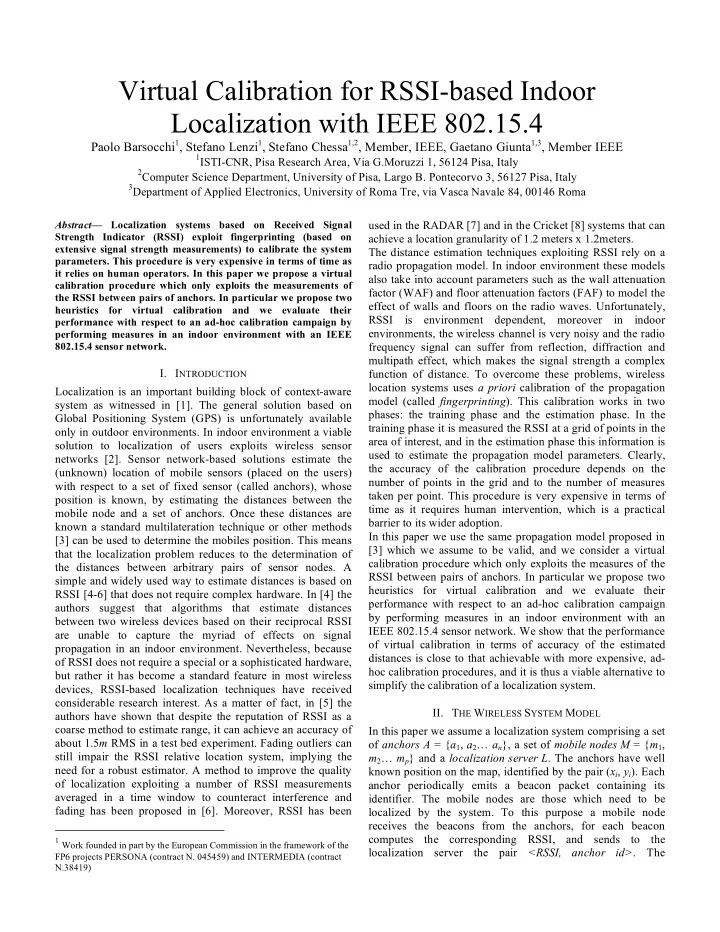

Virtual Calibration for RSSI-based Indoor Localization with IEEE 802.15.4 Paolo Barsocchi 1 , Stefano Lenzi 1 , Stefano Chessa 1,2 , Member, IEEE, Gaetano Giunta 1,3 , Member IEEE 1 ISTI-CNR, Pisa Research Area, Via G.Moruzzi 1, 56124 Pisa, Italy 2 Computer Science Department, University of Pisa, Largo B. Pontecorvo 3, 56127 Pisa, Italy 3 Department of Applied Electronics, University of Roma Tre, via Vasca Navale 84, 00146 Roma used in the RADAR [7] and in the Cricket [8] systems that can Abstract — Localization systems based on Received Signal Strength Indicator (RSSI) exploit fingerprinting (based on achieve a location granularity of 1.2 meters x 1.2meters. extensive signal strength measurements) to calibrate the system The distance estimation techniques exploiting RSSI rely on a parameters. This procedure is very expensive in terms of time as radio propagation model. In indoor environment these models it relies on human operators. In this paper we propose a virtual also take into account parameters such as the wall attenuation calibration procedure which only exploits the measurements of factor (WAF) and floor attenuation factors (FAF) to model the the RSSI between pairs of anchors. In particular we propose two effect of walls and floors on the radio waves. Unfortunately, heuristics for virtual calibration and we evaluate their RSSI is environment dependent, moreover in indoor performance with respect to an ad-hoc calibration campaign by environments, the wireless channel is very noisy and the radio performing measures in an indoor environment with an IEEE 802.15.4 sensor network. 1 frequency signal can suffer from reflection, diffraction and multipath effect, which makes the signal strength a complex I. I NTRODUCTION function of distance. To overcome these problems, wireless location systems uses a priori calibration of the propagation Localization is an important building block of context-aware model (called fingerprinting ). This calibration works in two system as witnessed in [1]. The general solution based on phases: the training phase and the estimation phase. In the Global Positioning System (GPS) is unfortunately available training phase it is measured the RSSI at a grid of points in the only in outdoor environments. In indoor environment a viable area of interest, and in the estimation phase this information is solution to localization of users exploits wireless sensor used to estimate the propagation model parameters. Clearly, networks [2]. Sensor network-based solutions estimate the the accuracy of the calibration procedure depends on the (unknown) location of mobile sensors (placed on the users) number of points in the grid and to the number of measures with respect to a set of fixed sensor (called anchors), whose taken per point. This procedure is very expensive in terms of position is known, by estimating the distances between the time as it requires human intervention, which is a practical mobile node and a set of anchors. Once these distances are barrier to its wider adoption. known a standard multilateration technique or other methods In this paper we use the same propagation model proposed in [3] can be used to determine the mobiles position. This means [3] which we assume to be valid, and we consider a virtual that the localization problem reduces to the determination of calibration procedure which only exploits the measures of the the distances between arbitrary pairs of sensor nodes. A RSSI between pairs of anchors. In particular we propose two simple and widely used way to estimate distances is based on heuristics for virtual calibration and we evaluate their RSSI [4-6] that does not require complex hardware. In [4] the performance with respect to an ad-hoc calibration campaign authors suggest that algorithms that estimate distances by performing measures in an indoor environment with an between two wireless devices based on their reciprocal RSSI IEEE 802.15.4 sensor network. We show that the performance are unable to capture the myriad of effects on signal of virtual calibration in terms of accuracy of the estimated propagation in an indoor environment. Nevertheless, because distances is close to that achievable with more expensive, ad- of RSSI does not require a special or a sophisticated hardware, hoc calibration procedures, and it is thus a viable alternative to but rather it has become a standard feature in most wireless simplify the calibration of a localization system. devices, RSSI-based localization techniques have received considerable research interest. As a matter of fact, in [5] the II. T HE W IRELESS S YSTEM M ODEL authors have shown that despite the reputation of RSSI as a coarse method to estimate range, it can achieve an accuracy of In this paper we assume a localization system comprising a set about 1.5 m RMS in a test bed experiment. Fading outliers can of anchors A = { a 1 , a 2 … a n }, a set of mobile nodes M = { m 1 , still impair the RSSI relative location system, implying the m 2 … m p } and a localization server L . The anchors have well need for a robust estimator. A method to improve the quality known position on the map, identified by the pair ( x i , y i ). Each of localization exploiting a number of RSSI measurements anchor periodically emits a beacon packet containing its averaged in a time window to counteract interference and identifier. The mobile nodes are those which need to be fading has been proposed in [6]. Moreover, RSSI has been localized by the system. To this purpose a mobile node receives the beacons from the anchors, for each beacon computes the corresponding RSSI, and sends to the 1 Work founded in part by the European Commission in the framework of the localization server the pair <RSSI, anchor id> . The FP6 projects PERSONA (contract N. 045459) and INTERMEDIA (contract N.38419)
Recommend
More recommend